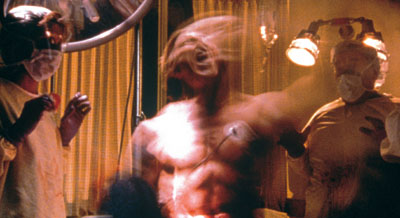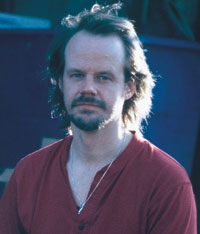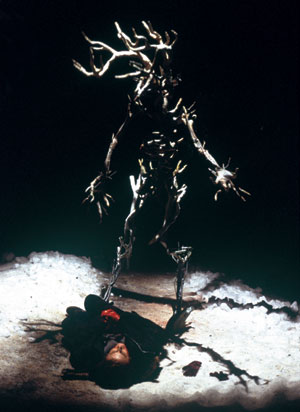SUPER NATURAL
Buried within the horror genre, Larry Fessenden has been quietly producing smart indie films for years. His new Wendigo may be his breakout picture. Travis Crawford talks with Fessenden.
For directors who begin their careers by making independent horror films, the trajectory that follows is often depressingly predictable: After making an impact with a low-budget, low-brow shocker, they subsequently spend years attempting to move away from the genre which afforded them their maiden success. Some never fully make the transition and eventually retreat back to genre work (George Romero), while others theoretically “advance” to lackluster mainstream filmmaking that never matches their ferocious debuts (Sam Raimi, Wes Craven). But judged on the basis of three distinctive and complex features forming a loose trilogy of revisionist horror exploration, indie director Larry Fessenden seems to be one of the few filmmakers likely to remain committed to his genre of choice. Fessenden’s latest, Wendigo, is the completion of the New York-based director’s aforementioned trilogy and his most fully realized work to date. The film is a finely crafted and superbly acted examination of loss and of society’s need for myth filtered through a traditional monster movie framework.
Fessenden began filmmaking by directing Super-8 projects like the hour-long Face in the Crowd (1980) before embracing video with more ambitious productions like the 1985 crime saga Experienced Movers and the ’89 docudrama Hollow Venus: Diary of a Go-Go Dancer. But his horror trilogy represents a significant career advance: The director’s ’91 feature No Telling (recently released on DVD) utilizes a Frankenstein-type tale of an experimental medical researcher in a country house as a means of commenting upon environmental issues and the ethics of animal experimentation. Yet it was his subsequent feature, Habit (1996), which would really cause genre devotees to take notice. Habit (actually a remake of the director’s identically titled ’81 video project) examines themes of drug addiction and contemporary urban alienation, all within an “urban vampire” storyline. Although Fessenden wound up self-distributing the pic, Habit edged him onto industry radar screens when it won him an IFP/West “Someone to Watch” Independent Spirit Award in 1997.
Wendigo, which premiered at Slamdance in 2001, continues Fessenden’s interest in renovating horror archetypes. An eerie, unsettling mood piece of mounting dread, Wendigo chronicles the tragic circumstances that envelop an affluent Manhattan family — Kim (Patricia Clarkson), George (Jake Weber), and their young son Miles (Erik Per Sullivan) — as they spend the weekend at a country house upstate. The group strike a deer with their Volvo and incur the wrath of an unbalanced local hunter. Shortly thereafter Miles is given a small figure representing the Native American spirit “Wendigo,” which triggers hallucinations (or premonitions) in the boy while also precipitating the film’s harrowing descent into violent family tragedy.
With Wendigo, Fessenden has constructed a deceptively simple tale that — like his previous work — is actually rich in metaphorical meaning. The film ultimately investigates how children cope with trauma and how notions of masculinity and family are defined in our chaotic modern age. Working with skilled actors, a spare visual style that is both stylized and realist in approach, and bizarre German Expressionist-influenced puppet/creature effects, Fessenden has created a quietly sad, emotionally affecting and finally unnerving horror film.
Whereas an older generation of independent horror filmmakers often toiled within the genre as a result of marketplace factors, Fessenden currently embraces horror cinema almost despite the career marginalization that arises as a result. Fessenden’s low-key scare excursions seem worlds away from the teen-driven self-parodies that masquerade as horror films in today’s climate. Yet his work is perhaps too genre-driven for the arthouse market. As an actor, Fessenden recently appeared in two films from director Brad Anderson, Session 9 and Happy Accidents, and the two directors’ filmmaking careers share some parallels: Both men create low-to-medium-budget entertainment which has them poised on the brink of mainstream acceptance ... but they’re not quite there. As Fessenden elaborates in this interview, that situation may soon change.
 |
FILMMAKER: You worked within other genres prior to No Telling, but over the past decade, you’ve basically stuck to horror films. Why have you become so fascinated with the genre?
LARRY FESSENDEN: I grew up watching horror films, and [the genre] provides an opportunity to use metaphor to tell another story alongside the story of the film — an alternative way to “read” the story. I always try to root my horror films in the everyday, yet by having a supernatural presence, it suggests a potential that surrounds our reality.
FILMMAKER: With respect to using the genre as a tool for metaphor, I was wondering if you construct your stories to consciously explore a specific theme in this way, or does a theme organically evolve after you establish a character-based storyline?
FESSENDEN: I think I respond to an environment through metaphor, and it’s true that [before starting out] I like to know what my movies are ultimately going to be about — the greater picture and the philosophical questions. From there, characters start to inhabit the situations and come to life. My films are very personal, but I also believe in an alternative reality where things have greater significance — that’s sort of how I perceive the world. I always read a great deal into a situation, and I see everything reverberate into a broader truth from a simple action. And in a way, that’s my approach to filmmaking.
FILMMAKER: How did the story of Wendigo originate? I admit to wondering if it was triggered by some type of personal experience with family loss.
FESSENDEN: Absolutely not! I actually had a perfectly smooth childhood. But I used to go to Vermont with my family, and once we had a minor accident where we slipped into a ditch in the dark, and I was trying to recall some of those memories. And in first grade, my teacher told this story of the Wendigo, which I will always remember — this image of a deer-man. Sitting down to write the screenplay triggered a series of these recollections, and then the story took over.
FILMMAKER: I’ve heard you remark that Habit was very heavily scripted, and that you wanted to adopt a sparer approach for the script of Wendigo.
FESSENDEN: Habit was a solid 120 pages of dialogue, and the first cut of that film was two hours and 45 minutes. I lamented that I didn’t have the time to show the city and the environment, because that’s a very important element in my films. So with Wendigo, I had a 70-page story, knowing that I would want to draw from the landscape and be able to make poetic imagery and create mood that way.
FILMMAKER: I was initially concerned that the film was going to lapse into the classic horror-film cliche of presenting the city people as evolved and sympathetic, and the country folk as primitive and brutal, but you play around with that notion in more complex ways.
 |
FESSENDEN: I tried to give a psychological depth or backstory to the one volatile hunter, and the others I suggest are always willing to help. I was certainly concerned about that, and it was never my agenda to have the country folk be “the other.” It’s also about the city guys being out of touch with the wilderness, and unable to communicate — the source of horror for me is people’s inability to relate. I don’t really take sides, as I think the father is also lost, and he doesn’t have all the answers either. I think it’s more of a male/female thing, with the woman being quite stable. I’m also dealing with the oppression of the American Indians, so that you see history as a perpetuation of aggression — the Indians were taken over, and now the urbanites are taking the country over from the settlers there.
FILMMAKER: Returning to your earlier work, what prompted you to remake your ’81 video project Habit 15 years later?
FESSENDEN: The first movie was extremely spare, and my ability to get a cast together was very limited. It’s a really tedious film, but the essence is the same — there’s a conversation between two friends that remains the centerpiece of both movies, and that’s almost intact. But the rest of the video Habit was not fleshed out, and it was really almost a sketch for the final film. It’s perhaps indicative of me that the scenes are the same — the loneliness, the alcoholism....
FILMMAKER: What’s it like to look back on your older video and Super-8 work now? Do you regret any decisions from that time?
FESSENDEN: Yeah, I regret the whole ’80s! I think I’ve never made a particularly good film, although I think some of my films are better than others. But there’s always an incompleteness — my budgets, my way of approaching the material, everything. I would actually like to remake all my films, since I start to figure them out once I’ve finished them. Beyond that, I also stand by the journey of the artist, and I see glimmers of what I’m still interested in doing with my old work, and in that way, I’m loyal to the old films. I know some people who won’t watch their movies, and I’m not in that camp — I’m intrigued by them.
FILMMAKER: There’s a phrase from your notes on Wendigo, where you refer to the film as “a small cinematic gesture.”
FESSENDEN: It’s a spare movie, a small film, and I have great affection for small films versus Hollywood “events” that try to show they’re the definitive word by becoming louder and louder. I like the idea that you can just make a film to maybe create a mood and an atmosphere, and that’s enough. I like to make films that are concise offerings.
FILMMAKER: You look back on horror films from the ’70s, and there are so many modest but effective genre films made then. Have you ever seen Let’s Scare Jessica to Death?
FESSENDEN: Yeah, sure!
FILMMAKER: It would be impossible to make a movie like that in today’s marketplace.
 |
| Larry Fessenden |
FILMMAKER: Still, do you have any desire to tackle “bigger” work, or is that simply not interesting to you at all?
FESSENDEN: You’re just allowed more flexibility if you’re not spending as much money. The enormity of the production when you’re on a set with money makes your choices less flexible. I love the idea of a mobile crew — look at Herzog, he made many classic films with just a handheld camera and a couple crazy people working with him. There’s an aesthetic with that — one that I grew up with — and it’s sort of been lost. I don’t know how to get it back, but it intrigues me to have a career of solid, small films. Now, maybe, that could mean up to $6 million, but not necessarily $30 to $80 million.
FILMMAKER: In terms of sustaining that career, do you see your allegiance to horror as being more of a help or a hindrance?
FESSENDEN: It’s been a huge help, because it allows people to categorize you, and I do feel that I have loyal fans. And I think that Habit, which could’ve been seen as an adolescent recollection, was given an edge by the horror genre, which made it a more visible project. So the genre has helped me a great deal. But one does wonder if it will keep me pigeonholed, since there are many ways to explore the issues I’ve discussed, and I can do that with comedies or other genres. I just have a sensibility that brings me back to the moods and the mysteries of the horror genre.
FILMMAKER: So I gather you just recently made a significant career advance, correct?
FESSENDEN: Yeah, I just made a deal with Ed Pressman, which was a fabulous career move. At the last moment, his company, ContentFilm, swept in and bought Wendigo [from Cowboy Pictures], so they’ll be ushering it into theaters — Magnolia will distribute it. Ed has shown interest in what I’ll do next, and the idea of having a mentor figure like that is very exciting, since he’s supported a lot of interesting directors over the years. With collaborators like him, I could easily make a bigger film. It’s just a matter of finding the right material.
VOD CALENDAR


 See the VOD Calendar →
See the VOD Calendar →



